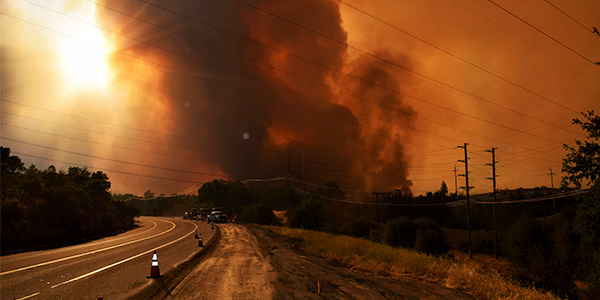By Hudson Sangree
All three of California’s big investor-owned utilities this week shut down power or warned customers they might need to because of dry, windy conditions that could lead to wildfires, prompting one consumer group to call for a probe into the practice.
It was the first time Pacific Gas and Electric has cut off power to consumers in Northern California based on fire hazards. Southern California Edison and San Diego Gas & Electric have taken such steps before when the hot Santa Ana winds picked up, as happened Monday and Tuesday.
With large fires becoming more the norm, and the state asking utilities to de-energize lines during severe weather conditions, California’s summer and fall fire season is becoming a time of rolling blackouts in fire-prone areas.
Some ratepayer advocates, however, criticized the utilities this week for jumping the gun. They said the power outages may have been more about avoiding liability and sending a political message than about protecting residents.
“We clearly think it’s blackout blackmail,” said Jamie Court, president of Consumer Watchdog, an advocacy group based in Los Angeles.
The IOUs and Gov. Jerry Brown had urged state lawmakers this year to do away with California’s unique system of holding utilities strictly liable for wildfire damage to private property. But the bill Brown signed in September, SB 901, left that strict-liability standard, often called inverse condemnation, unchanged.
The new law requires utilities to file wildfire mitigation plans with the state that include procedures for shutting down power in extreme weather to prevent fires. (See California Wildfire Bill Goes to Governor.)
“They didn’t get inverse condemnation [changed],” Court said. “They want to get out of liability forever for everything, and this is the way they send a signal. The biggest power a utility has is the ability to turn off power.”
‘Last Resort’
PG&E spokeswoman Angela Lombardi said the decision to cut off power this week was solely about wildfire prevention.
“Power safety shutoff will only be done as a last resort,” Lombardi told RTO Insider. “It’s only in the interest of public safety.”
The company took the unprecedented step Sunday and Monday of shutting off power to about 60,000 customers and notifying 37,000 others they could lose power because of gusting winds and dry vegetation in the northern San Francisco Bay Area and the Sierra Nevada foothills near Sacramento. (See PG&E Shuts down Power to Prevent Fires.)
State fire authorities have blamed PG&E’s equipment for sparking numerous fires in Northern California during the 2017 fire season, one of the most destructive in California’s history. The utility is facing billions of dollars in damages for those blazes, which occurred during times of high winds and low humidity.
In Southern California, San Diego Gas & Electric notified 4,700 customers Sunday their power could be shut off “with the onset of Santa Ana winds and extremely low vegetation moisture forecasted for the next two days.” The company ended up cutting power to 360 customers living in the foothills near the Cleveland National Forest and had restored power to most as of Tuesday. A red-flag warning remained in effect.
SDG&E, widely considered a state leader in wildfire prevention, has de-energized lines a number of times in the past because of hazardous fire conditions.
Southern California Edison issued warnings this weekend that it might have to shut down power as hot, dry Santa Ana winds began blowing from the desert to the ocean. The winds are typically a harbinger of Southern California’s wildfire season, which tends to peak in the fall but has become more of a year-round problem in recent years with drought and climate change.
CPUC Monitoring
Court, with Consumer Watchdog, said the conditions that prompted the utilities to shut down power were not sufficient to cut off power, especially to schools and to the elderly and infirm, including those who rely on oxygen machines.
“If there are no fires or firefighters in an area, there is no reason for a utility to shut down power unless they know they have faulty equipment or problems with vegetation management,” he said.
Consumer Watchdog sent a letter to California Public Utilities Commission (CPUC) President Michael Picker on Tuesday urging him to launch an investigation of PG&E’s power shutdown and to “investigate each and every time a utility turns out the lights due to high winds.”
In an email, CPUC spokeswoman Terrie Prosper said the commission had been monitoring this week’s power shutdowns and warnings.
“We will do a post-event review, including the factors that went into PG&E’s decision to de-energize, customer outreach and notification and restoration times.”
In general, Prosper added, “the state’s investor-owned utilities have general authority to shut off electric power to protect public safety under California law, specifically California Public Utilities Code (PU Code) Sections 451 and 399.2(a).
“The utilities have recently developed programs to exercise this authority during severe wildfire threat conditions as a preventative measure of last resort,” she said.





